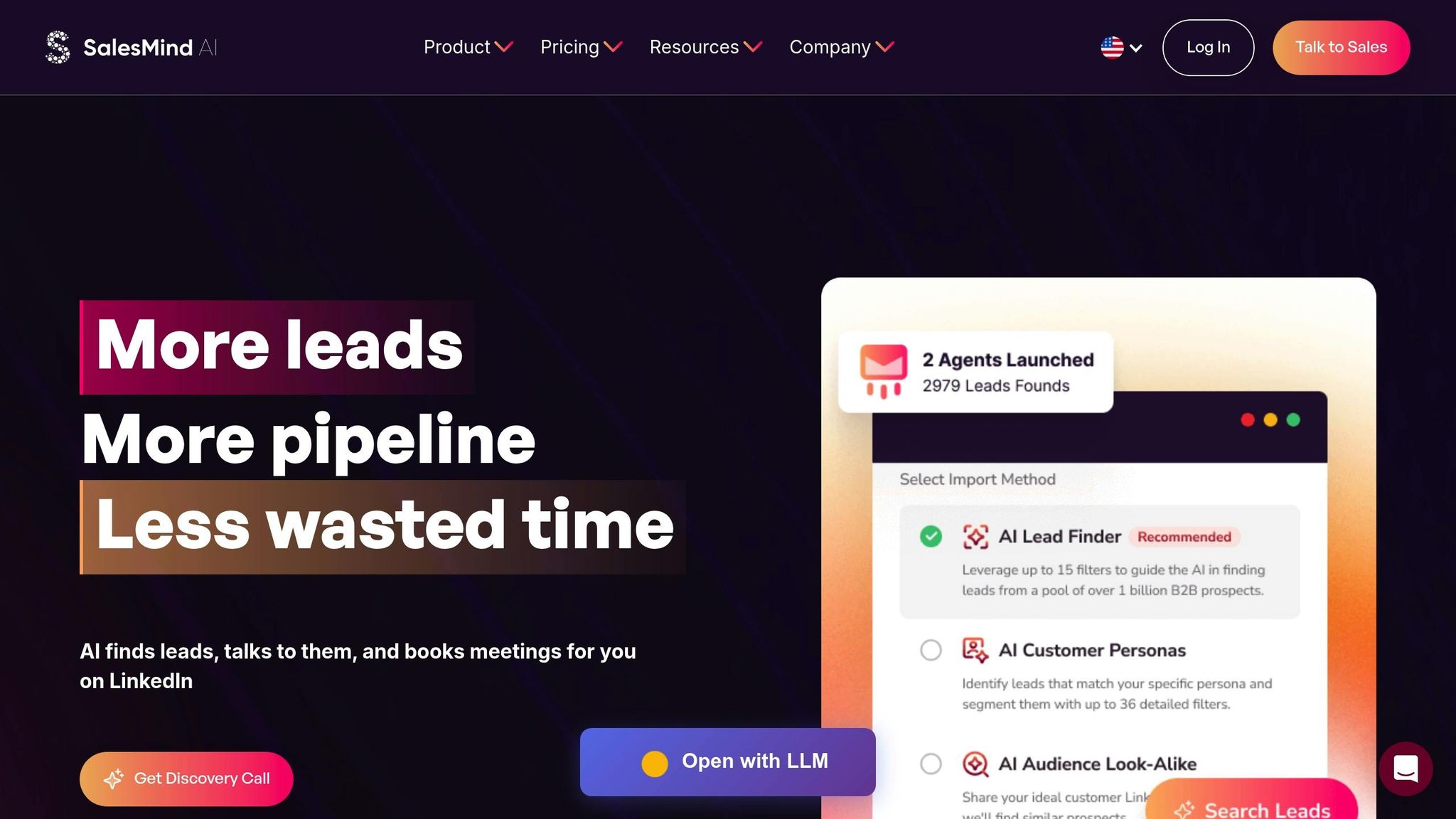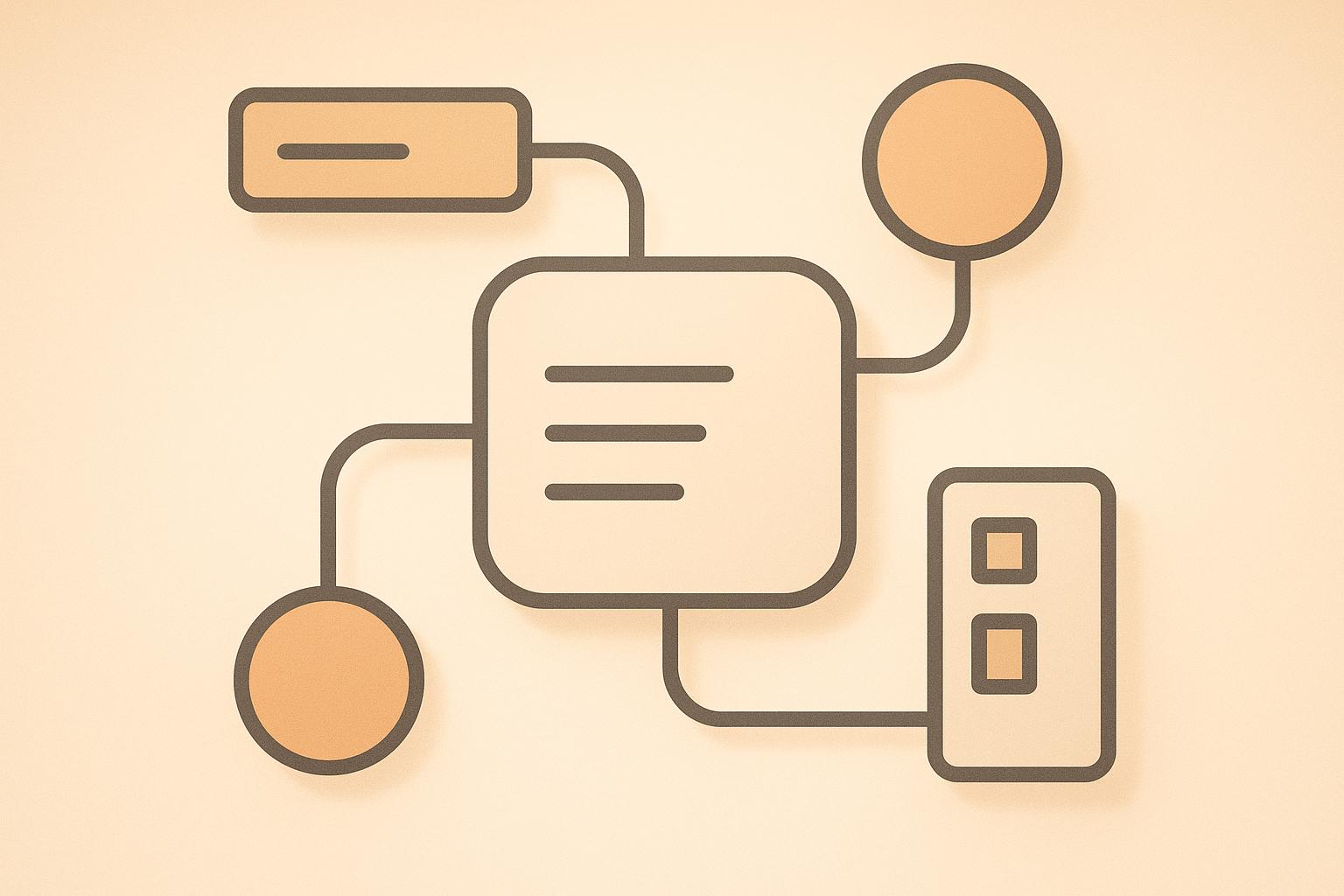
.avif)
Julien Gadea
Julien Gadea specializes in AI prospecting solutions for business growth. Empowering businesses to connect with their audience with SalesMind AI tools that automate your sales funnel, starting from lead generation.
Predictive analytics is transforming B2B sales by using data to forecast outcomes, prioritize leads, and personalize outreach. Here’s why it matters:
- Accurate Forecasting: Predictive models analyze past data to create forecasts with 85–95% accuracy, helping teams plan resources and hit revenue targets.
- Better Lead Qualification: Advanced scoring systems rank leads by their likelihood to convert, saving time and increasing conversion rates by up to 20%.
- Personalized Outreach: Data-driven insights enable tailored communication, boosting engagement and deal size by 75% in some cases.
If your sales team struggles with outdated methods, missed opportunities, or inefficient lead prioritization, predictive analytics offers a clear path to improvement. Tools like SalesMind AI integrate CRM and LinkedIn data to streamline processes and deliver actionable insights.
Key takeaway: Companies using predictive analytics report faster decision-making, higher conversion rates, and larger deal sizes. Don’t wait - evaluate your data readiness, choose the right tools, and start small with a pilot project to see the impact.
How Do Data Analytics Predict B2B Sales Deal Outcomes? - Find Sales Jobs
Key Benefits of Predictive Analytics for B2B Sales
Shifting from traditional sales methods to predictive analytics isn't just a trend - it delivers real, measurable results. Companies using predictive analytics are twice as likely to hit their targets compared to those sticking with older methods. Plus, they can speed up decision-making by as much as 20% [2]. Let’s dive into three ways predictive analytics is reshaping B2B sales and turning challenges into opportunities.
Better Sales Forecasting
Getting accurate sales forecasts has always been a challenge, but predictive analytics is making it far more achievable. By analyzing historical sales data, customer behaviors, and market trends, these tools uncover patterns that might otherwise go unnoticed.
Predictive analytics processes massive amounts of data, stripping out human bias and error, to deliver more accurate revenue predictions. This precision helps businesses plan their finances, manage inventory, and allocate resources more effectively. When your sales team knows which deals are likely to close and when, they can focus their energy where it matters most.
According to McKinsey & Company, companies using advanced analytics see a 15–20% improvement in marketing performance [3]. This edge comes from being able to anticipate market changes and customer needs faster than competitors.
Improved Lead Qualification
Another game-changer is how predictive analytics improves lead qualification. One of the biggest hurdles in B2B sales is wasting time on leads that never convert. Predictive analytics tackles this issue with advanced lead scoring models that evaluate prospects based on their actual likelihood to convert.
These models go beyond simple demographics or website activity. They analyze deeper factors like engagement, firmographics, and behavior to rank leads by their potential value. This allows sales teams to zero in on high-value opportunities.
For example, a B2B company used predictive analytics to automate the prioritization of sales accounts, leading to an 8.08% boost in renewal bookings [2]. By focusing on data-driven insights, teams can avoid chasing dead ends and instead work smarter, not harder.
"The lead scoring system is particularly impressive, providing clear insights into lead quality."
- Svit Babarovic, Food and Beverage Retail, MountainDrop [1]
Personalized Customer Outreach
Let’s face it - generic messaging just doesn’t cut it anymore. Buyers expect tailored experiences that address their specific needs. Predictive analytics makes this possible at scale by analyzing customer preferences, purchase history, and engagement patterns.
These tools go beyond cookie-cutter templates, using data to craft outreach that feels personal and relevant. The result? Higher engagement rates and better conversion opportunities.
Take Henry F., an Enterprise Account Executive at Salesforce, as an example. By using SalesMind AI's predictive messaging, which tailored responses based on his website and other sources, Henry saw 4–5 responses per day during an 8-day free trial [1].
"I've been impressed with some of the AI-recommended messaging. They pulled information from my website and other sources to curate recommended responses."
- Henry F., Enterprise Account Executive, Salesforce [1]
Similarly, freelance professional Sébastien D. used predictive analytics to personalize his outreach by pulling insights directly from prospect profiles. This approach not only boosted the quality of his outreach but also helped him secure more meetings and close more deals [1]. Meanwhile, Alex L., CTO at Slash Co, saw a 10x increase in lead prospecting productivity, with the AI initiating 5 to 10 new conversations per week from day one [1].
When outreach feels personal and relevant, prospects are much more likely to engage. This leads to better conversations, stronger relationships, and ultimately, more closed deals. Predictive analytics ensures that every interaction is meaningful and impactful.
Data Sources and Methods for Predictive Analytics
The success of predictive analytics relies heavily on high-quality data and the right analytical techniques. Here's a closer look at the essential components that bring predictive analytics to life in B2B settings.
Main Data Sources for Predictions
Predictive analytics draws from a variety of data sources, each offering unique insights:
- CRM Records: Provide historical trends and customer interactions.
- Communication Channels: Email, calls, and social media reveal engagement levels and buyer sentiment.
- Website and Behavioral Data: Tracks how prospects interact with your content - such as which pages they visit and how much time they spend. For instance, frequent visits to product pages paired with quick email responses often signal strong purchase intent.
- Market Trend Data: Offers context on industry shifts, competitor activity, and economic factors that influence buying decisions. This external perspective helps refine predictions.
- Third-Party Firmographic and Technographic Data: Fills in gaps about prospect companies, detailing their technology stack, company size, and growth patterns. This information is invaluable for qualifying leads and tailoring outreach strategies.
By combining these diverse datasets, businesses can turn raw information into actionable insights that drive better decision-making.
Methods for Creating Predictions
Predictive analytics employs a mix of statistical models and machine learning techniques to process data and generate insights:
- Machine Learning Algorithms: Tools like regression analysis, random forests, and neural networks analyze historical data to spot patterns, classify prospects, and segment customers. These algorithms improve over time as they process more data.
- Behavioral Pattern Recognition: Identifies sequences of customer actions that indicate buying intent or disengagement. For example, attending multiple demos followed by frequent visits to pricing pages often signals a high likelihood of conversion.
- Classification Models: Categorize leads based on their probability of converting, helping sales teams prioritize efforts. These models evaluate multiple factors simultaneously to assign scores and streamline lead qualification.
The most effective platforms combine multiple methods, creating a comprehensive view of customer behavior and market trends. By integrating different approaches, businesses can capture nuances that a single algorithm might overlook.
Combining Different Data Types
Blending structured data (like CRM records and transaction histories) with unstructured sources (such as emails, call transcripts, and social media) enhances predictive accuracy. This integration helps uncover subtle patterns - like changes in communication frequency or shifts in engagement timing - that signal a prospect’s readiness to buy.
For example, one B2B company that integrated CRM, email, and social media data reported larger deal sizes and faster pipeline progression compared to relying on a single data source [5].
However, integrating diverse data types isn’t without challenges. Issues like data silos, inconsistent formats, and quality concerns can complicate the process. Still, companies that successfully navigate these hurdles often see 20% higher conversion rates and improved marketing performance [3][4].
Platforms like SalesMind AI showcase how effective integration works by combining LinkedIn, CRM, and messaging data to optimize lead scoring and enhance predictive insights.
To make this work, businesses must establish strong data integration workflows and adopt consistent data governance practices. Regular cleaning and validation ensure models remain accurate as conditions change. When executed well, combining multiple data types turns predictive analytics into a powerful tool that drives measurable sales success.
sbb-itb-817c6a5
How to Implement Predictive Analytics in B2B Sales
Approach predictive analytics with careful planning and a commitment to learning. Jumping in without preparation often leads to poor outcomes. Building a strong foundation is essential before rolling out predictive models.
Check Your Organization's Readiness
Before diving into predictive analytics, evaluate whether your business is prepared. This step helps avoid expensive missteps.
Assess Data Quality: Start by examining the quality of your sales and customer data. Is it complete, accurate, and standardized? Look for data silos that may exist between departments, ensure records are current, and identify any gaps. Even the best predictive models will fail if the underlying data is unreliable.
Review Your CRM Infrastructure: Your CRM system needs to support data integration, provide real-time updates, and allow for data exports. It should capture both structured data, like sales transactions, and unstructured inputs, such as emails and call notes. Additionally, make sure your CRM integrates easily with analytics tools and supports data-cleaning processes [6][2].
Verify Team Alignment: Sales and marketing teams must work together seamlessly for predictive analytics to succeed. Shared goals and collaborative workflows are essential for turning insights into actionable results.
Conduct a thorough data audit across all customer touchpoints. Review CRM data, email interactions, website analytics, and third-party sources. Document what’s available, what’s missing, and how systems are interconnected. Once you’ve confirmed your organization’s readiness, focus on selecting tools that integrate well with your existing systems.
Select the Right Tools and Platforms
Choosing the right predictive analytics platform is critical. The wrong choice can drain resources and frustrate your team, while the right one boosts efficiency and adoption.
Key Platform Features: Look for tools that offer robust predictive modeling, user-friendly interfaces, and scalability. Features like lead scoring, opportunity forecasting, and customizable dashboards are particularly helpful. Strong vendor support is also important for overcoming implementation challenges and providing training [6].
Integration Matters: Ensure the platform integrates well with your CRM and LinkedIn workflows. LinkedIn integration is especially valuable for B2B sales, as it allows you to leverage social signals, track engagement, and automate personalized outreach. This capability enhances lead qualification and improves conversion rates by giving you a more complete picture of prospect behavior [6].
Take SalesMind AI as an example. This platform combines LinkedIn outreach automation with advanced lead scoring and CRM integration. Its AI-powered inbox simplifies lead qualification and follow-up, while real-time data analysis supports personalized engagement across your entire prospect list.
When evaluating platforms, create a checklist of must-have features and nice-to-have options. Test integration capabilities during trial periods, and involve your sales team in the decision-making process to ensure the tool fits their workflow.
Deploy, Monitor, and Improve Your Models
Start small with a pilot project to test your approach before scaling up.
Pilot Projects: Launch a pilot with clear KPIs and regular feedback loops to fine-tune your predictions. This step-by-step method builds confidence and proves the value of predictive analytics before full deployment [6][2].
Track Performance: Use monitoring systems to evaluate model accuracy, lead conversion rates, and sales forecasting. Regularly compare predicted outcomes to actual results, investigate discrepancies, and adjust as needed. Dashboards and automated alerts can help your team stay on top of performance [6][5].
Commit to Continuous Improvement: Predictive models need regular updates to stay relevant. Collect user feedback, retrain models with fresh data, and incorporate new data sources as they become available. Collaboration among sales, marketing, and data science teams is critical for ongoing success [6][2].
The results of a well-executed strategy can be transformative. One B2B company that followed this approach accelerated pipeline progression by 41% and increased average deal size by 75%. They generated $41 million in qualified deals and connected with previously unreachable accounts [5].
To keep your models performing at their best, schedule monthly performance reviews and quarterly sessions to incorporate new data or adjust algorithms. This consistent maintenance ensures your predictive analytics efforts remain effective as your business evolves and market conditions shift.
SalesMind AI: Predictive Analytics for LinkedIn Outreach

SalesMind AI takes the guesswork out of LinkedIn outreach by combining predictive analytics with automated prospecting. It personalizes outreach at scale, solving common challenges like generic messaging and inefficient lead qualification. By using predictive models to refine each step of the process, SalesMind AI shifts away from outdated methods that rely on manual lead sorting and one-size-fits-all communication - problems that often lead to low response rates and wasted time. The platform integrates LinkedIn and CRM data seamlessly, ensuring every interaction is both timely and targeted.
Features That Support Predictive Analytics
At the heart of SalesMind AI is its predictive lead scoring system, which evaluates LinkedIn activity, engagement history, company details, and behavioral signals. This system ranks prospects by their likelihood to convert, giving sales teams a clear roadmap for prioritizing leads. Beyond that, the platform’s AI-driven personalized messaging goes far beyond standard templates. It analyzes prospect profiles and company data to craft messages that are customized and relevant, replacing the impersonal outreach methods that fail to connect.
"SalesMind AI transforms lead generation with an intuitive interface and smart automation. The lead scoring system is particularly impressive, providing clear insights into lead quality."
- Svit Babarovic, Food and Beverage Retail, MountainDrop [1]
The platform also features automated follow-ups, which monitor prospect responses and engagement levels. Using predictive models, it schedules messages at the most effective times, saving users countless hours of manual effort. In fact, some users report generating 4–5 meaningful responses per day within just over a week [1].
These tools work together to ensure that every interaction is informed by real-time data, making outreach both efficient and effective.
LinkedIn and CRM Integration
SalesMind AI directly integrates with LinkedIn, pulling in real-time data like engagement metrics, profile updates, and interaction history. This ensures its predictive models always work with up-to-date information, giving users a competitive edge.
Another standout feature is the unified inbox, which centralizes LinkedIn conversations across multiple accounts. This makes it easier for sales teams to track engagement patterns and spot prospects showing buying intent.
"It's the best tool out there to curate your audience on autopilot while focusing on higher-leverage tasks."
Additionally, the platform’s CRM synchronization eliminates the need for manual data entry. Lead scores, interaction histories, and predictive insights flow directly into existing sales workflows, giving reps actionable data right when they need it.
Increasing ROI with Data-Driven Insights
Predictive analytics platforms like SalesMind AI have been shown to deliver measurable results. Companies using these tools report up to 20% higher conversion rates and a 15–20% boost in marketing performance compared to traditional methods [3][4]. One B2B company using SalesMind AI built 183 new relationships with previously unreachable accounts, achieving a 110% improvement in sales performance [5].
"Amazing tool that allowed me to save so much time on my LinkedIn outreach. But that's not all, by automating all conversations and personalizing them with direct insights extracted from my prospect profiles, it gives accurate and high-quality outputs that helped me get more prospect meetings and thus close more deals!"
- Sébastien D., Freelance - Information Services, Freelance Insider [1]
The Future of Predictive Analytics in B2B Sales
B2B sales are undergoing a rapid transformation, with predictive analytics playing a central role in driving this change. Companies that rely on data-driven strategies are seeing improved sales performance, while those sticking to traditional methods risk falling behind. Predictive analytics has become a critical tool for staying competitive, and its influence on the sales process is only set to grow.
Key Takeaways
Predictive analytics has already proven its value in areas like forecasting, lead qualification, and customer engagement. Moving forward, it will continue to strengthen these advantages and reshape B2B sales strategies.
At its core, predictive analytics eliminates guesswork, replacing it with informed, data-backed decisions. This shift impacts three key areas that directly affect revenue:
- Forecasting Accuracy: Advanced models provide more reliable sales forecasts by leveraging real-time insights. Teams can adjust to changing market conditions and allocate resources more effectively, leaving behind outdated methods like gut instincts or historical averages.
- Lead Qualification: Predictive scoring systems analyze multiple data points to assess prospects and assign conversion probabilities. This approach allows sales teams to focus on high-potential leads, saving time and improving conversion rates.
- Personalized Customer Engagement: By identifying behavioral patterns and buying signals, predictive analytics helps sales teams deliver tailored, timely communications. This personalization strengthens relationships and boosts response rates.
Metrics show that predictive analytics accelerates decision-making and enhances conversion rates, underscoring its transformative role in the entire B2B sales cycle.
Next Steps for Businesses
For businesses looking to integrate predictive analytics into their sales strategy, a thoughtful and strategic approach is key. Here’s how to get started:
- Evaluate Your Current Setup: Begin by assessing your existing data infrastructure and team capabilities. Identifying gaps early on will help ensure a smoother implementation process.
- Choose the Right Tools: Selecting the right platform is crucial. Tools like SalesMind AI demonstrate the potential of blending predictive insights with social data. Features like advanced lead scoring and automated personalization highlight the tangible benefits of proper implementation.
- Invest in Training and Cultural Shifts: Introducing predictive analytics requires more than just new technology. Sales teams need training to understand and use predictive insights effectively, transitioning from intuition-based selling to a data-driven approach. Leadership support is essential to foster this shift.
- Start Small: Pilot projects are a great way to test predictive analytics on a smaller scale. These initiatives provide valuable insights, allowing businesses to refine their processes before rolling out the technology more broadly.
The companies that act quickly and embrace predictive analytics now will gain a significant edge. Early adopters are better positioned to secure stronger market footholds and develop advanced capabilities as AI and machine learning technologies continue to evolve.
Waiting too long to adopt predictive analytics could mean missed opportunities and falling behind competitors. In today’s fast-paced B2B landscape, that’s a risk few businesses can afford to take.
FAQs
How can a company assess its readiness to use predictive analytics in B2B sales?
To figure out if your company is ready to dive into predictive analytics for B2B sales, the first thing to look at is your data. Predictive analytics thrives on data that's accurate, consistent, and well-organized. So, having a solid data management system in place is a must.
Next, take a close look at your team's comfort level with data-driven decision-making and analytics tools. If there's a gap in experience, it might be worth investing in some training or teaming up with a provider that offers easy-to-use tools and reliable support. Lastly, make sure your sales processes are well-defined. Predictive analytics works best when it's applied to structured workflows with clear, measurable goals.
What should I look for in a predictive analytics platform to improve B2B sales?
When selecting a predictive analytics platform for B2B sales, it’s crucial to focus on features that directly improve your sales strategies and decision-making. Prioritize tools that provide precise forecasting, sophisticated lead scoring, and practical insights designed to meet the needs of your industry.
It’s also important to choose platforms that integrate effortlessly with your current CRM and sales tools. This ensures seamless workflows and consistent data management. Factors like user-friendliness, scalability, and reliable customer support play a big role in achieving long-term success. Picking a solution that aligns with your sales objectives can help streamline operations and boost revenue.
How does predictive analytics enhance lead qualification in B2B sales?
Predictive analytics transforms the way businesses assess and prioritize leads by leveraging data-driven insights. Instead of relying on outdated or manual methods, it digs into patterns, behaviors, and historical data to pinpoint prospects with the highest likelihood of converting. The result? A smarter allocation of time and resources.
What sets predictive analytics apart is its use of advanced algorithms to score leads. These scores are based on factors like engagement levels, company size, and even industry trends. This means your sales team can zero in on high-value opportunities, working more efficiently and driving greater revenue potential.




